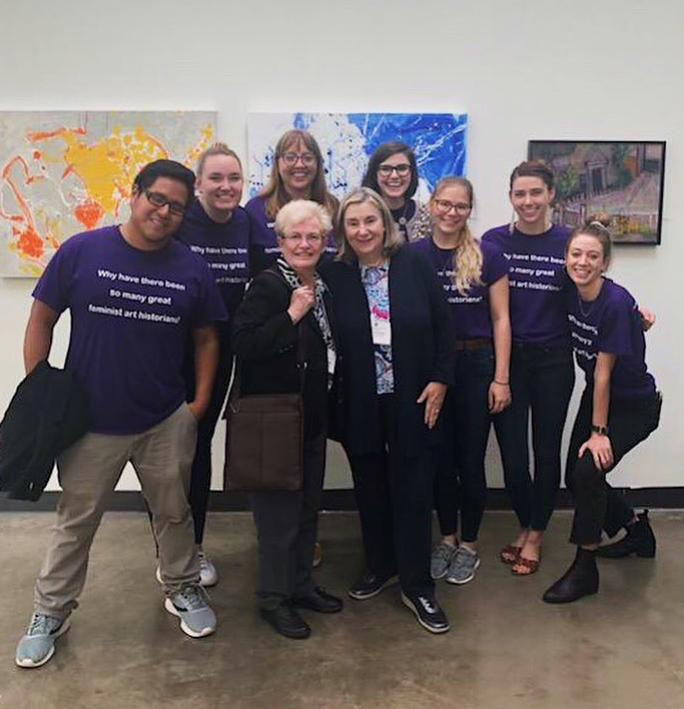Thirteen Years of Breaking Boundaries: AU's Feminist Art History Conference

“You won’t see a field being shaken up like you will in this space,” says Art History professorial lecturer Tiffany Hunt. American University's well-known legacy of activism is alive and well in its Art History Program, which will host its eighth Feminist Art History Conference from September 29–October 1 with virtual and in-person events. Registration is free for AU students, faculty, and staff, $75 for the general public, and $30 for non-AU students. See the full schedule and register.
Hundreds of attendees from around the globe will have access to 73 prerecorded presentations, live Zoom Q&A sessions, and two keynote speeches livestreamed from the Katzen Arts Center’s Abramson Family Recital Hall. Sherry Lindquist from Western Illinois University will present “Hieronymus Bosch's Nudes,” and Nikki Greene from Wellesley College will present “Rest: A Pedagogy of Art and Care.” Together, their talks span 400 years of history and will introduce audiences to new ways of thinking about historic male artists’ depictions of women and the ways in which female-identified artists and thinkers lead feminist lives.
Three AU graduates, once immersed in a feminist art history education, are returning to make their mark on the conference this year. Carolyn Russo (MA ‘20), curator at the Smithsonian National Air and Space Museum, presents “Challenging A Cultural Narrative: Contemporary Women Artists Embrace Feminism in the Realm of Flight.” Tori Burke (MA’ 21), PhD student at Emory University will read “A Generation of Vipers: The Physiologus, the Woman-Serpent, and the Viper's Lesson,” and Brianna Cooney (MA ‘23) presents “A Feast for the Senses, A Feast for the Intellect: The Maiolica Patronage of Eleonora Gonzaga.”
Why Feminist Art History?
American University’s Art History Program was founded by Professors Emeritae Norma Broude and Mary D. Garrard on the principals of feminist art history, which emerged in the 1960s to challenge the discipline’s focus on male artists. Feminist art history researches and promotes women artists and questioning prevailing gender stereotypes throughout art history. The field has broadened towards global and intersectional feminism to include issues of sexuality, gender identity, race, class, and ability.
“There are other feminist art history conferences out there. One of the things that sets this one apart is that it’s intersectional, international, and transhistorical,” says Art History professor Nika Elder. “We have papers addressing ancient art and papers addressing contemporary art. It’s an opportunity to think through what has and hasn’t changed in the field.” The sheer breadth of scholarship in the conference covers disciplines well beyond traditional art history, including curatorial practice, museum studies, education, history, and activism.
Art historical research is focused on much more than the art of the past. It can help us interpret the present and shape the future, particularly how to envision a more equitable society. “At a moment of backlash when women’s rights are being taken away, when scientifically unsupportable notions of strict gender binaries are being legislatively enforced, feminist art history is one way to resist dangerous attempts to romanticize patriarchy,” says Lindquist.
 Opening the Dialogue
Opening the Dialogue
While other art history conferences only feature research by mid-level to senior scholars, the AU conference is open to everyone from MA and PhD candidates to independent scholars to published experts in the field. “First, we select papers based on their quality. We’re open to new topics and ideas—we ask ourselves what’s pressing and relevant to the field,” says Elder. “The conference becomes a forum where people can experiment with new methodologies. We’re trying to not do feminist art history as it’s always been done.”
This spirit of democratization carries throughout the conference, from its affordable pricing tiers to Q&A sessions that encourage a dialogue between all attendees. “Our students jump right into discussions,” says Hunt. “It’s a community that’s nurturing but still rigorous and critical. It’s giving everyone a seat at the table.”
Because papers were pre-recorded and streamed virtually, the conference has attracted a national and international audience of attendees and presenters. Papers are delivered by scholars from China, Italy, Mexico, France, Poland, Sweden, and Canada, and on an equally global array of artists. One panel, “New Horizons: Feminist Art History in South America Now” features three scholars from Brazil, Chile, and Argentina addressing the state of feminist art history in South America.
Featured panels address such relevant topics as the Politics of Design, Historical Recovery in Museums, and Art as Activism/Activism as Art. Pre-recorded videos are now available for viewing ahead of the conference’s official start. Learn more about the conference and register.
